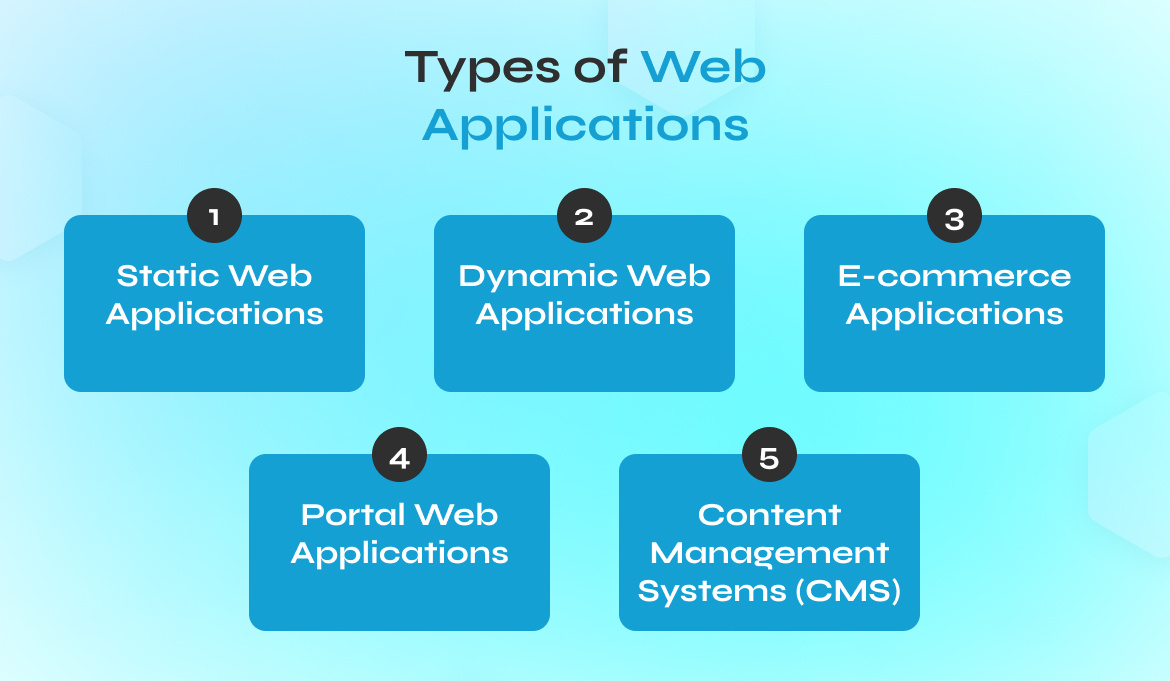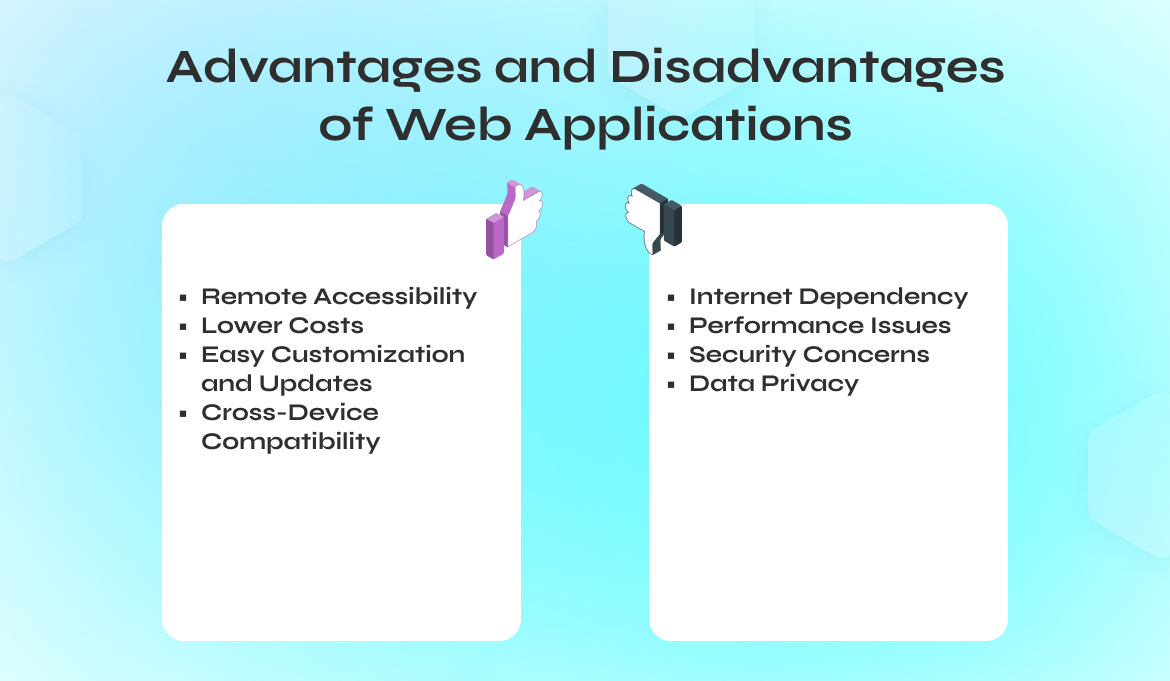Web applications have been an essential part of our lives, offering interactive, browser-based tools like Gmail or Trello and many more. These applications, accessible anywhere via the internet, differ from traditional, locally installed software by being hosted on web servers. Evolving from static to dynamic, they are vital in personal and professional areas, blending desktop app functionalities with unmatched accessibility.
This article will discuss various types of web applications, their benefits, and their increasing importance in our daily digital interactions.
Understanding Web Applications
Web applications have redefined how we interact with the internet, offering more than just information – they provide interactive experiences and functionalities compared to traditional software. At its core, a web application is a client-server program. The server provides the application, and the client (typically a web browser) accesses it. This setup allows web applications to be universally accessible as long as there’s an internet connection.
How Web Applications Work
Unlike traditional desktop applications that are installed on your local computer, web applications work over the internet. They store data on remote servers and deliver it to users over the web. This architecture makes web apps incredibly versatile and accessible from various devices, be it a computer, a smartphone, or a tablet.
Technologically, web applications use a combination of server-side scripts (like PHP and ASP) to handle the storage and retrieval of information and client-side scripts (like JavaScript and HTML) to present information to the user. This combination allows for interactive features, such as form submission, content updates, and user interaction, without the need to reload the entire page.
The Framework Behind Web Applications

The development of web applications often involves frameworks that provide the necessary components to build efficient and secure applications. These frameworks, like Angular, React, or Django, offer pre-written components and tools, making the development process faster and more streamlined. They ensure that web applications are scalable, maintainable, and can handle high volumes of traffic.
Web applications have grown in complexity and capability, moving from simple static web pages to dynamic, responsive, and interactive platforms. This evolution has enabled them to perform a wide range of functions, from simple displays of data to complex business processes.
In summary, web applications represent a significant shift in how applications are delivered and used, emphasizing accessibility, efficiency, and cross-platform functionality.
Types of Web Applications

Web applications come in various forms, each tailored to meet different needs and functionalities. Understanding these types is crucial for both users and developers, as it helps in selecting the right kind of web application for specific purposes.
1. Static Web Applications
Static web applications are the simplest type. They display content that doesn’t change often. Built using HTML and CSS, they are quick to develop and easy to host. However, their static nature means they are not suitable for situations requiring dynamic content or user interaction. Examples include digital portfolios and professional landing pages.
2. Dynamic Web Applications
Dynamic web applications are more complex and interactive. They use server-side programming languages like PHP, JavaScript, or Python to generate content dynamically. These applications can interact with databases, allowing for personalized user experiences and content that updates in real time. Blogs, e-commerce sites, and social networks are common examples.
3. E-commerce Applications
E-commerce applications are a specialized type of dynamic web application specifically designed for online sales. They offer functionalities like shopping carts, payment processing, and inventory management. Platforms like Shopify and Magento are popular examples.
4. Portal Web Applications
Portal web applications offer different sections or categories like forums, emails, and search engines, all accessible from a common interface. Examples include university portals and government service portals.
5. Content Management Systems (CMS)
A CMS is a web application designed to make it easy for non-technical users to create, edit, and manage a website. They have an admin panel for managing content, making them ideal for blogs, news, and e-commerce sites. WordPress and Joomla are widely used CMS platforms.
Each type serves specific needs, from simple information sharing to complex business functionalities. Choosing the right type depends on the requirements of the business or individual, such as the need for real-time content updates, user interaction, or e-commerce capabilities.
Benefits of Web Applications
Web applications have transformed how businesses and individuals use and interact with software. They offer numerous benefits that make them an attractive choice over traditional desktop applications.
- Accessibility and Convenience
One of the most significant advantages of web applications is their accessibility. They can be accessed from anywhere, at any time, as long as there is an internet connection. This universal accessibility makes them ideal for businesses with remote teams or users who need to access data and services on the go.
- Cross-Platform Compatibility
Web applications are designed to work across multiple platforms. Whether you are using a Windows PC, a Mac, an Android smartphone, or an iPhone, web applications provide a consistent experience, eliminating the need for multiple versions of the same application for different operating systems.
- Scalability and Maintenance
With web applications, scalability becomes more straightforward. As your business grows, web applications can be scaled up to accommodate increasing traffic and data. Additionally, updates and maintenance are done on the server, ensuring all users have access to the latest version without needing to install updates manually.
- Cost-Effectiveness and Efficiency
Web applications reduce both the initial costs and the ongoing expenses of software management. They eliminate the need for extensive infrastructure, reduce software maintenance costs, and cut down on support requirements. By running on browsers, they also reduce hardware dependency, allowing older machines to run newer applications.
- Enhanced Security
Although security is often cited as a concern for web-based applications, they can be more secure than traditional applications. Regular updates and centralized data storage can enhance security measures. Additionally, data backup and recovery are often more straightforward with web-based systems.
These benefits demonstrate why web applications have become a popular choice for businesses and individuals alike. They offer a blend of accessibility, cost-effectiveness, and adaptability that traditional software applications struggle to match.
Real-World Examples of Web Applications

To understand the impact and versatility of web applications, let’s look at some real-world examples. These applications have become integral to our daily digital interactions, both in personal and professional contexts.
Google Docs
Google Docs is a prime example of a dynamic web application. It allows users to create, edit, and share documents online in real time. Its ability to support multiple users simultaneously, offering collaborative editing and sharing capabilities, showcases the power of web applications in enhancing productivity and teamwork.
Trello
Trello, a popular project management tool, uses the concept of boards, lists, and cards to organize and prioritize projects. As a web application, it provides a flexible and user-friendly interface for team collaboration, accessible from any device with an internet connection, demonstrating the convenience and efficiency of web applications.
Twitter, now X, is a widely used social media platform and a prominent example of an influential web application. In 2017, Twitter launched its web app, becoming one of the most high-profile instances of this modern technology. It allows users to share short messages or “tweets,” follow trends, and engage in social interactions, exemplifying the role of web applications in global communication and information sharing.
Shopify
Shopify is an e-commerce platform that allows individuals and businesses to set up their online stores. It epitomizes the functionality of e-commerce web applications, offering tools for inventory management, payment processing, and customer engagement, all within a user-friendly, accessible online platform.
WordPress
WordPress, primarily known as a content management system, powers a significant portion of the internet’s websites. It allows users to create, manage, and publish content easily, exemplifying how web applications can democratize content creation and website management.
These examples highlight how web applications have become essential tools in various sectors, from business and education to project management and e-commerce. They illustrate the practical application of web applications in solving real-world problems, improving efficiency, and enhancing user experience.
Advantages and Disadvantages of Web Applications

While web applications offer numerous benefits, it’s important to consider both their advantages and disadvantages to understand their impact fully.
Advantages of Web Applications
- Remote Accessibility: Web applications can be accessed from anywhere, making them ideal for modern work environments that include remote work and global collaborations.
- Lower Costs: They often require less upfront investment compared to traditional software, as they usually operate on a subscription basis and don’t need extensive hardware.
- Easy Customization and Updates: Since web applications are server-based, updates and customizations can be deployed quickly and uniformly, ensuring all users have access to the latest version.
- Cross-Device Compatibility: Being browser-based, they work across various devices and operating systems, which is crucial in our increasingly mobile world.
Disadvantages of Web Applications
- Internet Dependency: Web applications require an internet connection to function. This reliance can be a significant drawback in areas with poor connectivity.
- Performance Issues: Sometimes, web applications might not perform as efficiently as dedicated desktop applications, especially if handling complex tasks or large volumes of data.
- Security Concerns: While web applications can be secure, the fact that they are accessed over the internet makes them vulnerable to security threats such as hacking and data breaches.
- Data Privacy: With data stored on remote servers, users often have concerns about data privacy and the potential misuse of personal information.
Understanding these advantages and disadvantages is crucial for businesses and individuals when deciding whether to adopt a web application. The key is to balance the benefits of accessibility, cost, and compatibility with the challenges of internet dependency, performance, and security.
Conclusion and Future Outlook
As we have explored, web applications play a vital role in today’s digital landscape. They offer a blend of accessibility, flexibility, and functionality that is hard to match with traditional software. From simple tasks like document editing to complex e-commerce solutions, web applications have made significant strides in how we interact with technology.
Embracing the Digital Shift
The move towards web applications reflects a broader shift in our digital habits. With the increasing adoption of cloud technology and the demand for remote accessibility, web applications are more relevant than ever. They bridge the gap between user needs and technological capabilities, offering solutions that are both efficient and user-friendly.
Balancing Benefits and Challenges
While web applications come with their share of challenges, particularly in terms of internet reliance and security, the advantages they offer often outweigh these concerns. The key lies in understanding these challenges and implementing strategies to mitigate them, such as robust security measures and reliable cloud services.
Looking to the Future
The future of web applications looks promising. As internet technologies continue to evolve, we can expect web applications to become more sophisticated, secure, and user-centric. The integration of emerging technologies like artificial intelligence, machine learning, and blockchain could further enhance their capabilities, offering more personalized and secure user experiences.
FAQs
What is a Web Application?
A web application is a software program that runs on a web server and is accessed through a web browser over the internet. Unlike traditional desktop applications, it doesn’t need to be installed on your computer.
How Do Web Applications Differ from Regular Websites?
While regular websites mostly provide static information, web applications offer interactive elements and user engagement, similar to desktop applications but accessible through a web browser.
What are the Key Benefits of Using Web Applications?
The main benefits include accessibility from any device with internet, no need for installations or updates on the user’s end, cross-platform compatibility, and often lower costs for users.
Can You List Some Types of Web Applications?
Common types include static and dynamic web applications, e-commerce platforms, content management systems, and portal web applications.
What are Some Examples of Web Applications?
Popular examples include Google Docs for document editing, Trello for project management, Shopify for e-commerce, and WordPress as a content management system.
What Makes Web Applications Advantageous for Businesses?
Web applications offer scalability, ease of maintenance, remote accessibility, and cross-device compatibility, which are crucial for modern businesses.
Are There Any Disadvantages to Web Applications?
The main disadvantages can include reliance on internet connectivity, potential performance issues for complex tasks, and security concerns.
How Secure are Web Applications?
While web applications can be vulnerable to online threats, regular updates, robust security protocols, and encrypted connections can significantly enhance their security.
Can Web Applications Work Offline?
Some web applications have offline capabilities, allowing basic functions without an internet connection, but they primarily require connectivity for full functionality.
Is it Costly to Develop a Web Application?
The cost varies based on complexity, features, and design requirements. However, they can often be more cost-effective than developing traditional software for multiple platforms.
At the end, applications are not just a trend; they are a fundamental part of our digital evolution. They have reshaped how we interact with technology and will continue to influence our digital experiences in the years to come. As technology advances, web applications will undoubtedly grow in importance, offering more innovative solutions to meet the ever-changing needs of users worldwide.



